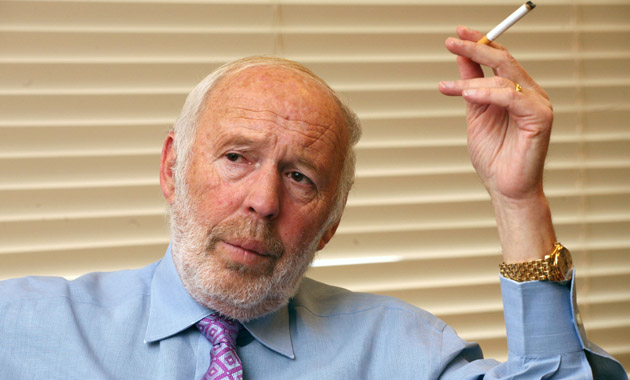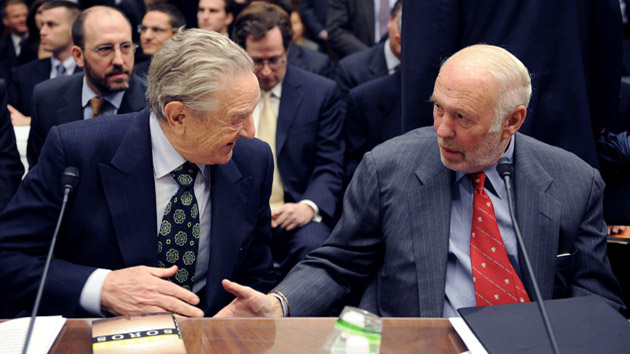
As Democrats and Republicans battle for control of the Senate, hedge funds are dumping millions of dollars into congressional campaigns. Most of these companies are lining up behind one party or the other. But the second-biggest spender, Long Island-based Renaissance Technologies, is playing both sides of the aisle. As of early September, the firm’s CEO, Robert Mercer, had given $3.1 million to Republican candidates and super-PACs. Its founder and chairman, James Simons—a brilliant former National Security Agency code breaker—had donated $3.2 million to their Democratic counterparts.
Neither man has spoken publicly about his motives, but the donations coincide with at least two federal investigations into Renaissance’s business dealings. In July, Renaissance executives were hauled before a Senate subcommittee and grilled about the company’s use of complex financial instruments to dodge billions of dollars in taxes and skirt federal leverage limits, which protect the financial markets from swings and crashes. As Sen. Carl Levin (D-Mich.) put it during the hearing, “excessive leverage” can “bring down not just a reckless borrower, but the financial institution that lent it money, and that failure can ripple through the entire financial system.”
The story of Simons’ evolution from math prodigy to NSA contractor to billionaire super-PAC donor reads like a Hollywood script. The son of a Massachusetts shoe factory owner, he graduated with a math degree from MIT when he was just 20 years old. Three years later, he earned a Ph.D. from the University of California-Berkeley, and returned to MIT, this time as a professor.
By 1964 Simons had moved on to the Princeton branch of the Institute for Defense Analyses, a nonprofit corporation that coordinates federally funded defense research at universities. His charge was to help the NSA crack Cold War code, but he locked horns with IDA’s president, Maxwell Taylor, a former chairman of the joint chiefs of staff. In 1967, Taylor published an article in the New York Times Magazine defending the US role in the Vietnam War. Simons, who was in his late 20s, dashed off a letter to the editor. “Some of us at the institution have a different view,” he wrote. “The only…rational defense policy is to withdraw with the greatest possible dispatch.”
Simons was later fired from IDA and took a job as chair of the math department at Stony Brook University. There, he earned a reputation as a big thinker. “His mind is open at a very wide angle,” says Jeff Cheeger, a professor of mathematics at New York University who served on the Stony Brook faculty with Simons. “He has an uncanny ability to pinpoint and solve problems that are of fundamental importance as opposed to just fashionable or obviously hard.”
Working with a renowned Berkeley geometer, Simons eventually created a new tool for gauging curved spaces, a development that would revolutionize theoretical physics and alter scientific understanding of everything from gravity to black holes. It also earned Simons the American Mathematics Society’s Veblen Prize, the world’s highest award for geometry.
After leaving Stony Brook in 1978, Simons launched an investment firm called Monemetrics in a Long Island strip mall. And four years later, he founded Renaissance. Working with a team of code breakers, programmers, and statistically minded science professors, Simons built a computerized system that scoured the markets for statistical anomalies, such as stocks that were trading below value. Returns were uneven, at least until Simons and his crew began experimenting with what is now known as high-frequency trading. They found it was far easier to predict how a given stock or commodity would move during the next few minutes or hours than to divine what would happen months down the track. Soon Renaissance was making thousands of trades each day and its flagship Medallion fund was delivering returns of 30 percent or more each year.
Simons eventually closed Medallion to new investors and began spinning off other funds that were open to outsiders. In 1993, he brought on two brilliant linguists, Robert Mercer and Peter Brown, who had worked at IBM and had helped create groundbreaking new speech-recognition models based on mathematics. The pair threw themselves into refining Renaissance’s secret algorithms. Brown, whose wife, Margaret Hamburg, now heads the Food and Drug Administration, often slept on a Murphy bed in the office and rode a unicycle around the firm’s leafy Long Island campus to save time. By 2000, Renaissance had grown from a dozen employees to nearly 150, and its Medallion fund, which was mostly insider owned, was returning more than 90 percent per year. Simons, who ranks No. 37 on the Forbes list of wealthiest Americans, bought a 220-foot superyacht called Archimedes and began taking his staff and their families on lavish vacations. One year, he reportedly flew hundreds of people to Bermuda for a weekend getaway. Mercer, then an executive vice president, built a $2 million model train set in the basement of his Long Island mansion. (He later sued the builder, claiming he’d been overcharged.)
Renaissance is notoriously secretive about its investment formula. But documents released by the Senate Permanent Subcommittee on Investigations in July offer some clues about the engine behind its growth. In 1999, Deutsche Bank—which did not respond to requests for comment—approached Renaissance and offered to package all of the Medallion fund’s investments into a portfolio, or “basket,” that was held in the bank’s name. Under this arrangement, Renaissance would still control the trades and reap all the profits (minus the bank’s generous fees). But it didn’t have to pay short-term capital gains taxes on the underlying assets, even if they were only held for a few hours or days. (Short-term gains are taxed at 39 percent for the highest earners; long-term gains are taxed at roughly half that rate.)
“Renaissance profited from this tax treatment by insisting on the fiction that it didn’t really own the stocks it traded—that the banks that Renaissance dealt with, did,” Sen. John McCain (R-Ariz.), the ranking Republican on the subcommittee, said during the recent hearing. “But, the fact is that Renaissance did all the trading, maintained full control over the account…and reaped all of the profits.”
The basket options also allowed Renaissance to skirt federal leverage limits. Normally, hedge funds can borrow a maximum of $2 for every $1 of their own capital they use to finance assets through brokerage accounts. But under its agreement with Deutsche Bank, Renaissance managed to borrow nearly 10 times that sum. It looked to outsiders as if the bank was simply shuffling its own funds.
Renaissance eventually pressed the British banking giant Barclays to begin offering basket option contracts too—and threatened to take its business elsewhere if the bank refused. According to the Senate investigation, Barclays agreed. (Barclays did not respond to requests for comment).
Then, in 2007, the first tremors of the financial crisis hit, and the quantitative hedge fund industry that Simons had helped pioneer suffered enormous losses, partly because the turmoil had short-circuited trading algorithms. Suddenly, these companies found themselves under federal scrutiny, and economists began pondering whether they posed a risk to the financial system.
Medallion weathered the turmoil better than most. The following year, when the financial meltdown struck, the fund still delivered 80 percent returns. Simons’ peers marveled at his savvy and resilience. “There are just a few individuals who have truly changed how we view the markets,” Theodore Aronson, a quantitative hedge fund manager from Philadelphia told Bloomberg. “John Maynard Keynes is one of the few…So is Jim Simons.”

But some of the Renaissance funds that were open to outside investors were floundering. The largest among them, Renaissance Institutional Equities Fund, fell by 16 percent in 2008 and lost another 6 percent in 2009. In May of that year, the Wall Street Journal reported that investors were upset about the gap between Medallion returns and those from other Renaissance funds and that, a month earlier, the Securities and Exchange Commission had begun inspecting the company’s books.
Simons resigned as CEO in November 2009 (though he remained chairman of the board) and handed the reins to Robert Mercer and Peter Brown. Meanwhile, the turmoil continued. The following spring, the Dow Jones Industrial plunged 1,000 points, only to rebound a few minutes later. It was the largest one-day swing in the Dow’s history. And, according to an SEC investigation, it was due largely to high-frequency trading, which now accounted for 60 percent of all market transactions.
After the “flash crash,” quantitative hedge funds found themselves under greater scrutiny. In November 2010, the Internal Revenue Service, which had been investigating Renaissance’s use of options to avoid taxes, issued a generic public memo. The memo found that hedge funds—not their partner banks—controlled the assets underlying basket options and should be paying taxes on their day-to-day trading. But Renaissance continued using options to avoid short-term capital gains taxes. (The company’s spokesman, Jonathan Gasthalter, told Mother Jones that Renaissance remains confident “the tax treatment for the option transactions are appropriate under current law.” Deutsche Bank eventually put a moratorium on new basket options but continued servicing existing ones, according to the Senate investigation.)
As federal agents pored over its books, Renaissance launched a political offensive. The company, which had been doing very little lobbying, spent $240,000 lobbying in 2010. The following year, it spent $740,000, almost all of it advocating on tax issues. Renaissance executives and directors were also pumping money into campaigns. In 2010, Mercer—a staunch conservative who helped finance the opposition to the Islamic center near Ground Zero—gave $200,000 to fund attack ads against Rep. Peter DeFazio (D-Ore.), who had sponsored bills to tax derivatives and high-frequency trading. During the 2012 election cycle, Mercer gave $5.5 million to Republican candidates and outside groups, including Karl Rove’s American Crossroads ($2 million) and Restore Our Future ($1 million), a super-PAC that backed Republican presidential nominee Mitt Romney. He also pumped nearly $1 million into a super-PAC that aimed to defeat Rep. Timothy Bishop (D-N.Y.), a former SEC prosecutor who had prosecuted white-collar fraud. (Renaissance is based in Bishop’s Long Island district.)
At the same time, Simons gave $9.6 million to Democratic candidates, campaign committees, and outside groups—more than any donor except former New York Mayor Michael Bloomberg and reclusive media mogul Fred Eychaner. Priorities Action USA, a super-PAC backing Barack Obama, was his largest beneficiary. Besides sinking $5 million of his own money into the group, the hedge fund billionaire hosted an event for prospective Priorities Action donors during the Democratic convention.
Viveca Novak of the Center for Responsive Politics, a nonpartisan group that tracks political giving, says it is not unusual for firms with business before Congress to give generously to both parties. “Often, the strategy is to make sure that you’ve got both sides covered,” she says. “It’s just smart politics.” But during the 2012 cycle, Renaissance was the only firm with super-PAC megadonors spreading huge sums to Democrats and Republicans.
According to documents released by the Senate subcommittee, in the spring of 2012, the Federal Reserve Bank of New York learned of Renaissance’s dealings with Deutsche Bank. As it turns out, two years earlier Deutsche Bank had admitted to participating in an unrelated tax shelter scheme involving billions of dollars in bogus write-offs for individuals. To avoid criminal prosecution, the bank had agreed to pay more than $550 million to the US government and to disclose any deals that might run afoul of US tax law.
After discovering the Renaissance arrangement, the Federal Reserve insisted that Deutsche Bank inform the Justice Department. Around this time, the bank began offering a new kind of basket options that no longer shielded clients from short-term capital gains tax, though hedge funds were still able to sidestep federal leverage limits. In 2013, Barclays followed suit.
By now, Renaissance had been under federal investigation for at least four years—though neither the SEC nor the IRS had cracked down on its activities—and the Senate subcommittee on investigations had begun probing the use of basket options by it and other hedge funds. With the 2014 midterm elections looming, Renaissance’s leadership began pouring more money into politics. Mercer gave to a variety of Republican candidates, right-leaning super-PACs, and anti-tax groups such as Club for Growth Action. Simons, on the other hand, donated $2 million to the Senate Majority PAC, which is fighting to retain Democratic control of the Senate, and $1 million to the Democratic House Majority PAC.
This July, as the subcommittee was preparing to unveil its findings at a hearing, the famously secretive Simons granted a wide-ranging interview to the New York Times. The paper ran a glowing profile, focusing on his philanthropy, his personal struggles, and his “ferocious curiosity.” It made no mention of his political giving. According to Steven M. Rosenthal, a tax policy expert who was called to testify, on the day of the hearing, Renaissance flooded the chambers with lawyers and lobbyists. “Their tentacles were everywhere,” he recalls.
The Senate investigation ultimately found that the hedge funds in question had been using “fictional” options to inflate profits and dodge taxes—Renaissance alone had earned more than $30 billion in profits and avoided an estimated $6 billion in taxes under this system. During the hearing, Levin, the subcommittee chairman, stressed these gains had come at the expense of ordinary Americans. “This structure…worked well for the hedge funds, which made billions of dollars in profits,” he said. “But it didn’t work for average taxpayers, who had to shoulder the tax burden these hedge funds shrugged off with the aid of the banks. And it didn’t work for the financial system, which is still recovering from a devastating crisis brought on by excess risk, and remains ill-equipped to withstand another shock from over-leveraged financial institutions.”
Levin has been pressing federal agencies—including the IRS, which is still investigating Renaissance’s business practices—to crack down on abusive tax shelters and collect additional taxes from hedge funds that used dubious options. But the six-term Michigan senator is retiring in January. The hedge fund lobbyists and megadonors aren’t going anywhere.














